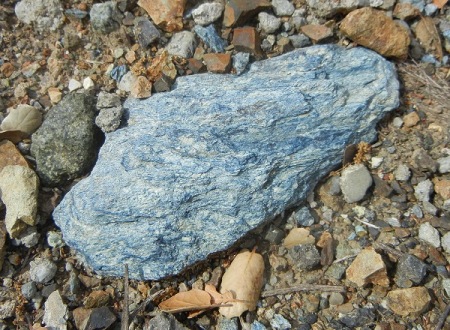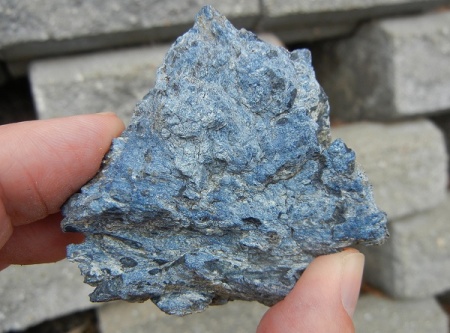The distinctive landscape of Knowland Park owes much to its large exposure of Franciscan melange, in which lumps of various rock types stick out of the ground like raisins in pudding (or whatever culinary simile you prefer). A few weeks back I featured the chert knockers, because there are so many, and this week’s subject is the ones that aren’t chert.
Here’s the geologic map showing the Franciscan area, labeled KJfm (for “Cretaceous/Jurassic Franciscan melange”). The places featured in this post are numbered 1 through 8 from north to south.
Knocker 1 isn’t really a knocker, but an exposure in the fire road, of greenish serpentinite.
I include it because there are relatively few in this piece of melange. Other melange areas, like those in San Francisco or Marin County, may be mostly serpentinite, but not here.
Knocker 2 is at the edge of a cul-de-sac overlooking the gorge of Arroyo Viejo. It’s a lovely greenstone.
A closeup shows the greenish rock, which is a metamorphosed lava, along with its iron-rich weathering rind and the carbonate veins that are evidence of its deep-sea origin (more here).
Knocker 3 is exposed along the road just above here, a nice graywacke, or dirty sandstone.
The Piedmont block, Oakland’s other body of Franciscan melange, is largely graywacke.
Knocker 4 is the big one, which caught my eye the first time I set foot in the park.
Its bluish color stands up to close inspection. This is a classic high-grade block, a body of rock that was carried deep into the Earth and returned to the surface quickly enough that the high-pressure blueschist minerals it turned into were preserved.
You have to look closely at these rocks to see past the lichens that tend to cover every exposed surface. Geologists carry hammers to ensure fresh exposures, but rocks in the park should not be hammered.
Knocker 5 is just up the hill. I haven’t given it a good look yet, but my initial impression is that it’s lava.
Knocker 6, across a small gully from knocker 4, is populated by a clump of trees. I think there’s a reason for that because the rock fractures nicely enough for the roots to reach deep.
I interpret it as metamorphosed lava, from its greenish color, extremely fine grained (aphanitic) character and massive fabric.
The next two knockers are outside the park — the Franciscan doesn’t honor property lines, and the Chabot Park neighborhood once looked just like Knowland Park.
Knocker 7 is on posted land at the end of the public part of Kerrigan Drive. I think it’s serpentinite . . .
. . . because that’s what’s underfoot here.
Knocker 8 is exposed along lower Lochard Drive and is too large to photograph easily. Looming over the road, it looks like basalt lava.
But a fresh exposure shows some cryptic internal features, plus extensive deposition of iron oxides from weathering below ground.
I’ve visited this site twice and am still not sure what to call it.
There are more knockers to be found in Knowland Park and south of the park. I plan to keep up my search to the south end of the Franciscan, along Chabot Reservoir.
Once again, I hope you’ll take part in the blog survey between now and November 20. It has prizes.
























